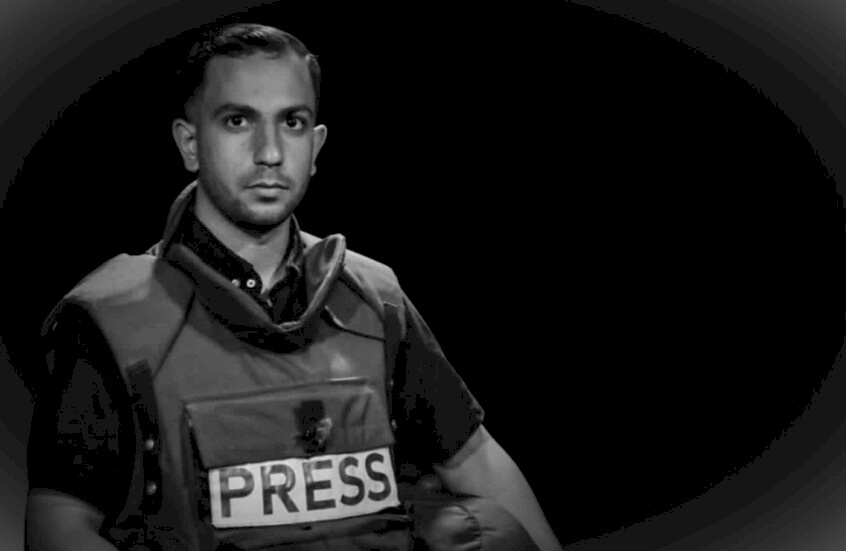
Journalist Syndicate: Main Indications of the Increased Targeting of Journalists with Murder, and Why Now the Killing of Anas Al-Sharif?
SadaNews - The Palestinian Journalist Syndicate has warned of the escalating crimes committed by the war criminal Netanyahu's government against Palestinian journalists, the latest of which was the targeting of working crews in the Gaza Strip, resulting in the martyrdom of six on Monday, 11/8/2025.
The Press Freedoms Committee affiliated with the union has issued this analytical report highlighting the key indications of the recent escalation.
Political and Strategic Indications
1. Attempt to control the media narrative – When the occupation authorities prevent or target local journalists and obstruct the presence of international media, access to independent images and opinions from the battlefield diminishes, which helps to establish the official narrative of the occupying force and reduces the impact of contradicting reports.
2. Deterrence message and internal politics – The war criminal Netanyahu's government is facing security and political pressures alongside a potential military expansion (as hinted by recent military plans); strict security policies and a rigid tone towards any Palestinian case, including journalists, might be used to gain an internal base or to instill deterrence.
This could practically translate into tightening security laws or allowing more open military operations in the coming days.
3. Targeting journalists as a security threat – The occupation authorities justify their crimes against journalists with "alleged connections" between media personnel and armed groups, aiming to give operational legitimacy in the context of war, but even the Israeli media did not buy their government’s narrative.
Legal and Human Rights Indications
1. Risks of war crimes and international responsibility – Targeting civilians, including journalists, falls under war crimes, as this is confirmed by intent, lack of discrimination, and failure to take precautions.
The Journalist Syndicate, through its Freedoms Committee, in the framework of monitoring and documentation, asserts that most incidents of journalists killed in the Gaza Strip amount to serious violations of press rights and international law.
2. Proving judicial and political repercussions – The increase in casualties will enhance our demands within the union and our efforts for the necessity of opening international investigations, legal actions, and diplomatic pressure campaigns, with a clear impact on the image and status of the Israeli occupation in international forums.
Field Indications
1. Changing rules of engagement – Targeting journalists, media institutions, the homes of journalists, and working crews indicates a change in the rules of engagement, suggesting a broader aggression without documentation and evidence and reports reaching the world.
2. Isolation of field coverage – Preventing foreign media from entering and covering events in the Gaza Strip, coupled with increased risks of killing, leads to reliance on local journalists who are less protected, which multiplies losses and raises the cost of independent documentation.
Human and Social Indications
- Destruction of professional infrastructure and "muzzling" of witnesses – As killings and injuries among journalists increase, the number who document crimes at the required level diminishes, leading to an increase in impunity for crimes and violations, and representing a blow to freedom of expression.
Why might this phase specifically witness an escalation?
1. New military context/operational expansion (plans to occupy parts of Gaza or escalate land operations) pushes the occupation forces towards more intensive and exposed operations, increasing the likelihood of injuries or targeting of journalists working in operational areas.
2. Regional tensions or other rounds of fighting (for example, the observed regional escalations between Israel, Iran, Hezbollah, and Syria) could be used to justify stricter internal and external security policies (closing offices of some media outlets and arresting some of their staff), coinciding with hostile media campaigns that increase risks to field journalists.
3. Official policies or justifying statements – When the occupation authorities classify media entities as "collaborative" with the enemy, they become potential targets within a broader military logic.
Potential Impacts
- Intensified reluctance of local journalists to cover field events, or imposition of self-censorship.
- Increased international pressure and calls for independent investigations.
- Loss of independent information sources inside Gaza, thus expanding the space for Israeli propaganda and unverified false claims.
Mohamed Al-Laham, head of the Freedoms Committee in the syndicate, commented on the report stating that targeting a journalist like Al Jazeera correspondent Anas Al-Sharif, who was martyred with his colleagues on Monday, is nothing but an indication of the validity of the indications, as he had been working openly for two years and would go out daily with live broadcasts from open and exposed locations, which raises the question: why now??
Now, killing him and his colleagues is required due to the impact of journalistic reports on Israel's image within the methodology of doubting everything coming from Gaza, and demonizing the Palestinian journalist to shake any trust in him as a reliable source in the terrorist thinking of Netanyahu's government, which neither wants to acknowledge genocidal crimes nor wants any evidence of them and has intentions to expand the scope of war.

Trump demands Hamas to quickly return the bodies of the captives: We will follow up in 48...

Trump Meets Emir of Qatar: Gaza Agreement Will Hold and Stability Force Will Be Ready Soon

Katz: Destroying Tunnels and Disarming Hamas is the Most Important Goal in Gaza

Mustafa Arrives in Riyadh to Participate in the Ninth Edition of the Future Investment Ini...

Egyptian Teams Enter Gaza to Participate in the Search for Israeli Remains

Settlers Attack the Bedouin Arab Ara'ara Community North of Occupied Jerusalem

A Child Seriously Injured by Occupation Gunfire in Tubas City

